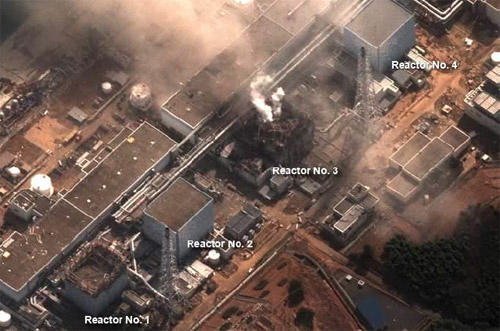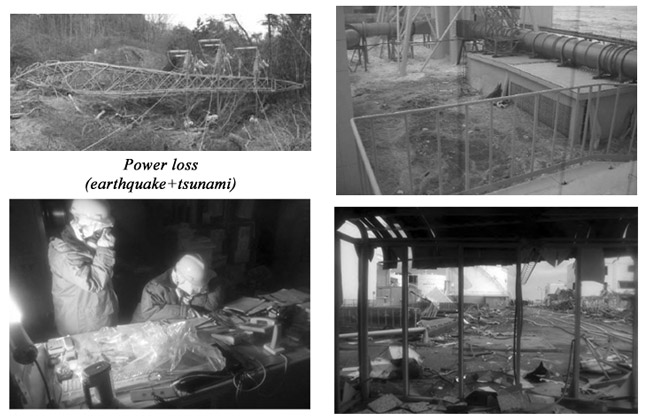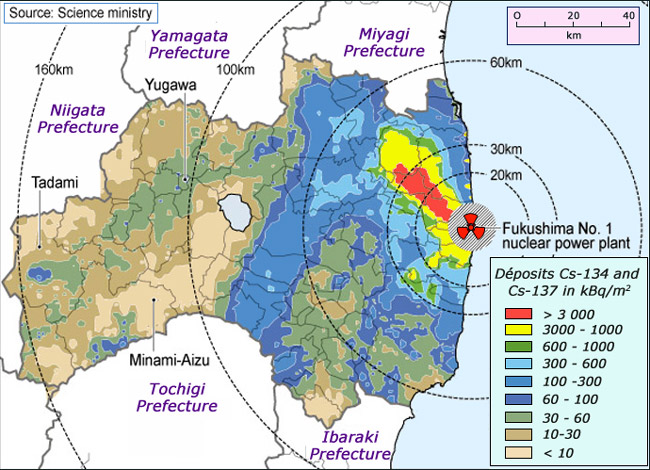A natural disaster worsened by human errors …
Several years have passed since the Fukushima accident. How to summarize its multiple aspects! What are its causes, circumstances, human and environmental consequences? Could it be avoided? What are the responsibilities? What lessons can be learned to prevent it from happening again?
On March 11, 2011, the safety of nuclear reactors underwent the baptism of fire of a major cataclysm: an earthquake of magnitude 8.9 followed by a tsunami that ravaged the coasts of Japan, causing nearly 30,000 deaths and missing persons.

Fukushima damaged reactors
In this photograph, smoke escapes from the roof of reactor No. 3 which has just been blown by an explosion, forty hours after the on that happened on unit 1. The explosion that was to occur on reactor No. 2 has yet to come. These non-explosions, but hydrogen explosions due to large amounts of hydrogen produced by the prolonged absence of cooling, and that leaked and mixed with air.
© Source : Japan Atomic Industrial Forum, Tepco
Aging Western nations, obsessed by its fears, have rapidly forgotten the tsunami, its deads and missing, to focus on the nuclear disaster. It forgets generally that radioactivity released by the accident at the Fukushima plant probably did not cost human lives or very little.
The accident was a cooling accident like the 1979 Three Mile Island that occurred in the United States. There was no atomic explosion! The reactors stopped automatically during the earthquake and with them the nuclear fission. But radioactive decays continue to generate heat. It was imperative to cool. However, the tsunami wave damaged and flooded the cooling circuits and back-up facilities, leading to a total loss of power supplies and main cooling equipments over long hours.
To these multiple failures, one should add dramatic conditions of intervention. Coastal towns and villages have been devastated by the tsunami, roads were impassable. The first teams must intervene as their lives have been upset and their families were looking for missing relatives.
The accident shows that extreme scenarios may happen, with the concomitance of multiple failures. The measures to be taken in such circumstances had not been envisaged and the management of the crisis and its multiple rebound took place « with a wet finger ».

Concomitance of multiple failures
The figure illustrates the concomitance of multiple failures. The loss of power due to the earthquake was followed by the flooding of emergency diesels and reserves of cooling water. During the first days operators has to intervene under a black out, without electricity and precise information on the state of the reactors. Later, the debris resulting from the hydrogen explosion which blown the upper part of reactor No. 3 hindered the cooling of the No. 2 reactor, which later on caused the main radioactive contamination.
© Source : Areva/TEPCO
One may cast a posteriori a frightened look at this poor management. However, the existing but insufficient devices have mitigated the accident. Containment barriers played their role and kept the bulk of radioactivity. Four days passed before the main release of radioactivity giving time to shelter populations.
The cores of the three damaged reactors at the Fukushima-Daiichi power plant remained long hours without water supply. As a result, the fuel rods were uncovered in the reactor vessels. Insufficiently cooled, their temperature exceeded 1000 ° C. The claddings covering the nuclear fuel lost their tightness and reacted with steam, releasing hydrogen. This gas leaked in the upper floors of reactors 1 and 3 where it exploded by contact with air.
The course of the accident was extremely complex with a whole series of twists and turns. For instance, debris from the explosion of the roof of reactor No. 3 interrupted the emergency cooling of the nearby reactor No. 2, causing later on an explosion in this reactor which produced the main release of radioactivity. If the cooling of No. 2 had not been interrupted, the pollution of the environment would probably have been much lower.

Legacy of cesium deposits
The main legacy of the accident for the environment is an area of high cesium contamination. This zone has the shape of a strip of a few kilometres wide and about forty kilometres long directed northwest. The explosion on 15 March 2011 on reactor N 2 was responsible for radioactive deposits. The approximate 600 km2 of the area (red, yellow and green on the map) is to be compared with the approximately 10 000 km2 of the special control zones (SCZ) areas defined after Chernobyl,
© Source : Japan Science Ministry
What are the human responsibilities? Let us be grateful for the dedication of the courageous teams that exposed their lives to control the accident under extreme conditions and remember the ancient adage: Criticism is easy, art is difficult (Polybius). That said, the responsibilities of the leaders are heavy. A report by the Japanese parliament severely condemns collusion in the regulation of the government of the time and the utility operator. In Japan, the Nuclear Safety Authority – NISA – depends on the all-powerful Ministry of Trade and Industry, the mythical MITI. The invocation of Nature furies and of the « Sotegai » – the unexpected – should not excuse failures. The financier outweighed the engineer, the profitability the safety. Warnings were ignored, tsunami risks minimized.
Located in northern Japan, the Onagawa nuclear power plant, which was closer to the earthquake epicentre and subjected even more violent shocks, did not suffer major damage because designed with sufficient safety margins. The Onagawa plant recorded seismic tremors that exceeded its nominal capacity, and the basement of one of its reactor buildings was flooded. But the plant maintained its cooling capacity, its reactors stopped without damage to their cores or significant damage to safety systems.
If the plant operator, TEPCO, had erected a higher dike, provided alternators and water supplies out of reach of flooding, installed hydrogen recombiners recommended by the IAEA, it would have avoided the loss of three of its reactors, and may be its ruin. More essential, it would have avoided large scale radioactive contaminations requiring the evacuation of 170,000 people around the plant.
If the losses of human lives due to radioactivity are likely to be small, the consequences are severe for the Society and the Japanese economy. First there is the human cost of evacuations and uprooting, and decontaminations. Then, as a result of a general shutdown of the Japanese reactors, it was necessary to import large quantities of gas and oil to produce electricity. Only an handful of them was allowed to restart in 2016 after upgrades and checks. By April 2014, Japan’s trade deficit had quadrupled. Finally, the use of thermal power plants increases the greenhouse effect and global warming.
There was an impressive succession of events, poor management coupled with a culture of « state secret » and a lack of transparency. Is it necessary, however, to question the merits of a powerful source of energy long symbol of progress? The examination of causes and circumstances shows that it would have needed relatively little to avoid the accident or to mitigate it altogether. One has to draw with cold blood the lessons of the event.
– Is Fukushima’s exclusion zone doing more harm than radiation?, march 2016, Rupert Wingfield-Hayes (BBC News, Tokyo)
Articles on the subject « Fukushima accident »
Fukushima : Events and Causes
March 11th 2011 : cascade of unlikely accidents … The earthquake The magnitude 9 earthquake[...]
Fukushima : Contaminations
Atmospheric releases and map of ground déposits The contaminations due to Fukushima radioactive r[...]
Fukushima decontamination
2014 -2017: Status of clean-up operations The major clean-up program of contaminated areas in Jap[...]
Fukushima Health Impact
Contamination and health controls in Japan The health impacts of the accident primarily concerned[...]
Fukushima today
A long way from reactors cold shutdown to their dismantling .. Today, 8 years after the accident,[...]